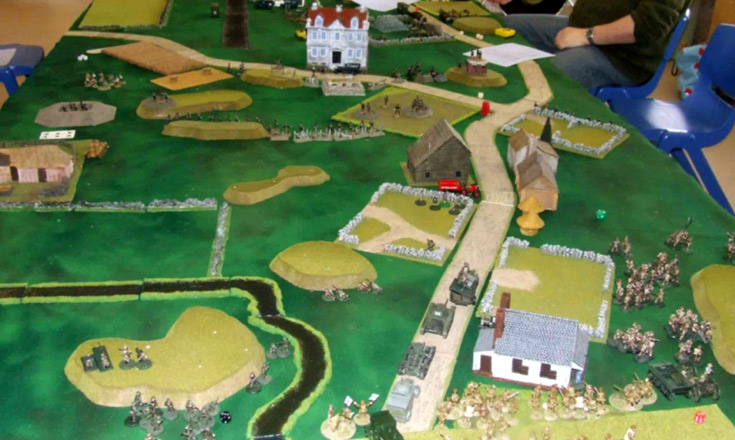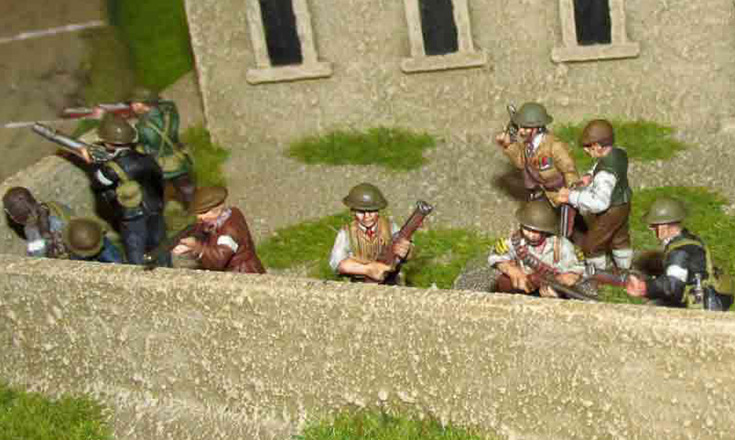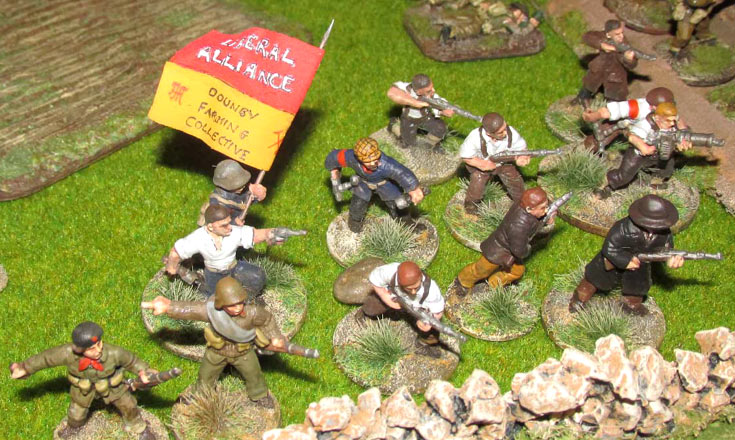
The Battle of Scatsa, Shetland, 1938
24th April 2013, 0 Comments
A Very British Civil War, Homegrown Rules, 28mm
In The Very British Civil War guide to the fighting in Scotland it says that; “Shetland occupies a strategic position for shipping between the Atlantic and the North Sea”. I beg to differ. This was written by a Shetlander with an axe to grind, as the barren, windswept hell-hole of an archipelago could quite easily be bypassed by the rest of the world and nobody would even notice the difference. Shipping going northwards around the British Isles transits through the Pentland Firth – it doesn’t go 80 miles out of its way to pass close to Shetland! The islands are about as strategically positioned as a trapped pawn on the uneventful side of a chessboard. Anyway, this game – set in the “alternative history” world of The Very British Civil War – is by its very nature a chance to suspend belief. In this world, Shetland is worth fighting for. The Shetland club (the Thule Gamers) have been playing their own Shetland-based VBCW campaign, which pits the forces of reaction – the Royalists supporting King Edward – against a coalition of various left-wing factions, supported by the interventionist troops of the breakaway Scottish republic. Their premise was that a battalion of Gordon Highlanders were stationed in the islands, and act as a nucleus for anti-government forces. In this alternative world, both sides have tanks – although even today Shetland only has a single main road. In this game, the two sides are tooled up with high quality kit – Boyes anti-tank rifles, 18-pounder field guns, Smith guns and an assortment of armoured vehicles, from Beaverettes to Matilda Is. That, of course, is part of the fun of the VBCW. It may be silly, but you get to play wish some unusual toys.
The Shetland club (the Thule Gamers) have been playing their own Shetland-based VBCW campaign, which pits the forces of reaction – the Royalists supporting King Edward – against a coalition of various left-wing factions, supported by the interventionist troops of the breakaway Scottish republic. Their premise was that a battalion of Gordon Highlanders were stationed in the islands, and act as a nucleus for anti-government forces. In this alternative world, both sides have tanks – although even today Shetland only has a single main road. In this game, the two sides are tooled up with high quality kit – Boyes anti-tank rifles, 18-pounder field guns, Smith guns and an assortment of armoured vehicles, from Beaverettes to Matilda Is. That, of course, is part of the fun of the VBCW. It may be silly, but you get to play wish some unusual toys. The game was laid on by the Thule Gamers, and three of us from Orkney were invited to take part. The scenario centred around Scatsa Airfield, a remote landing strip in the very north of Shetland, near the present-day oil terminal of Sullom Voe. The north of he island were held by the government, led by the Lord Lieutenant of Shetland. His men had found a secret package of some sort, and had to hold the airfield until a plane from London arrived to whisk it to safety. Trying to stop them were the Gordon Highlanders, accompanied by the forces of the left, while on the far side of the table a sneak attack by Norwegian interventionists was also being launched, in an attempt to seize the same package. Defending the airfield and its environs were the local Home Guard, police and paramilitary units, a well-equipped local militia, and the Lord Lieutenant’s British Union of Fascists bodyguard.
The game was laid on by the Thule Gamers, and three of us from Orkney were invited to take part. The scenario centred around Scatsa Airfield, a remote landing strip in the very north of Shetland, near the present-day oil terminal of Sullom Voe. The north of he island were held by the government, led by the Lord Lieutenant of Shetland. His men had found a secret package of some sort, and had to hold the airfield until a plane from London arrived to whisk it to safety. Trying to stop them were the Gordon Highlanders, accompanied by the forces of the left, while on the far side of the table a sneak attack by Norwegian interventionists was also being launched, in an attempt to seize the same package. Defending the airfield and its environs were the local Home Guard, police and paramilitary units, a well-equipped local militia, and the Lord Lieutenant’s British Union of Fascists bodyguard. The game began with an all-out assault by the Gordon Highlanders and the left wing militia, but the latter were stopped short when two Czech-built tanks appeared, owned by the right wing militia. One was immobilised, but for the rest of the game the militia were pinned near their table edge, unable to advance, and unable to counter the enemy armour. Over on the far side of the table the Norwegians advanced towards the airfield, but spent several turns clearing a Shetland Local Defence Volunteer outpost in a hamlet sitting behind a small stream (burn). The Norwegians eventually cleared the strongpoint, but the defenders bought time with their lives, allowing the Lord Lieutenant to rush up police reinforcements. It looked like the line would hold, and the game on this side of the table seemed to be heading towards a stalemate.
The game began with an all-out assault by the Gordon Highlanders and the left wing militia, but the latter were stopped short when two Czech-built tanks appeared, owned by the right wing militia. One was immobilised, but for the rest of the game the militia were pinned near their table edge, unable to advance, and unable to counter the enemy armour. Over on the far side of the table the Norwegians advanced towards the airfield, but spent several turns clearing a Shetland Local Defence Volunteer outpost in a hamlet sitting behind a small stream (burn). The Norwegians eventually cleared the strongpoint, but the defenders bought time with their lives, allowing the Lord Lieutenant to rush up police reinforcements. It looked like the line would hold, and the game on this side of the table seemed to be heading towards a stalemate. Back on the main front the Gordons continued their steady advance, harassed by a small armoured assault by two Beaverette personnel carriers. There was only room in each one for one gunner – the first man had a Lewis gun, while the second vehicle’s gunner was armed with a double-barrelled shotgun. They fired into the flank of the Scots interventionists, causing several casualties for the loss of the Lewis gunner. Then the Scots came under fire from a machine gun emplacement, and the Matilda I was sent forward to take on the right-wing strongpoint. By this stage the game was getting interesting. Both sides were taking casualties, and the commanders had to rethink their initial plans. At that crucial moment Mike McEwan the umpire rolled the requisite dice and the plane arrived. The Lord Lieutenant and his bodyguard were ready and waiting on the edge of the runway, and after loading the mystery package aboard the plane roared off again. Effectively this meant the game was over. The Left-wing alliance could still try to make headway, but it was now clear that the defences were stronger than they’d anticipated. Without the prize of the package, and because this was tied into an on-going campaign game then the assault was called off.
Back on the main front the Gordons continued their steady advance, harassed by a small armoured assault by two Beaverette personnel carriers. There was only room in each one for one gunner – the first man had a Lewis gun, while the second vehicle’s gunner was armed with a double-barrelled shotgun. They fired into the flank of the Scots interventionists, causing several casualties for the loss of the Lewis gunner. Then the Scots came under fire from a machine gun emplacement, and the Matilda I was sent forward to take on the right-wing strongpoint. By this stage the game was getting interesting. Both sides were taking casualties, and the commanders had to rethink their initial plans. At that crucial moment Mike McEwan the umpire rolled the requisite dice and the plane arrived. The Lord Lieutenant and his bodyguard were ready and waiting on the edge of the runway, and after loading the mystery package aboard the plane roared off again. Effectively this meant the game was over. The Left-wing alliance could still try to make headway, but it was now clear that the defences were stronger than they’d anticipated. Without the prize of the package, and because this was tied into an on-going campaign game then the assault was called off. The game played reasonably well, but we could have used a few more hours to see it to a conclusion. The haste was largely our fault – the three Orcadians were due to be whisked off to Mike’s house for Sunday lunch before heading down to catch their own flight back to civilization. The rules were essentially Warhammer’s Wild West gunfighting rules, adapted slightly to take tanks, vehicles and big guns into account. I’m not really a big fan of the Warhammer system – too many pointless die rolls – but it seemed to work reasonably well. When we play our VBCW games down in Edinburgh and Orkney we tend to use either Brigadier 38 by Solway games (a set specifically designed for this “period”) or else Triumph and Tragedy. Actually, I’m not that fond of T&T either, but Colin Jack in Edinburgh is, and he’s the real impetus behind the VBCW down there. Its certainly inspired me to paint up some more figures for this, and who knows – we might even have a game some time in the next few weeks…
The game played reasonably well, but we could have used a few more hours to see it to a conclusion. The haste was largely our fault – the three Orcadians were due to be whisked off to Mike’s house for Sunday lunch before heading down to catch their own flight back to civilization. The rules were essentially Warhammer’s Wild West gunfighting rules, adapted slightly to take tanks, vehicles and big guns into account. I’m not really a big fan of the Warhammer system – too many pointless die rolls – but it seemed to work reasonably well. When we play our VBCW games down in Edinburgh and Orkney we tend to use either Brigadier 38 by Solway games (a set specifically designed for this “period”) or else Triumph and Tragedy. Actually, I’m not that fond of T&T either, but Colin Jack in Edinburgh is, and he’s the real impetus behind the VBCW down there. Its certainly inspired me to paint up some more figures for this, and who knows – we might even have a game some time in the next few weeks…




